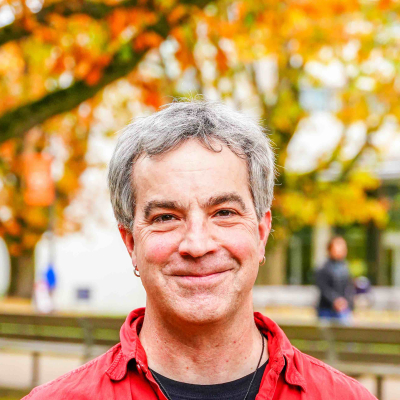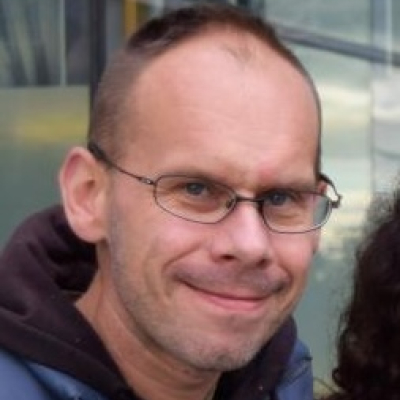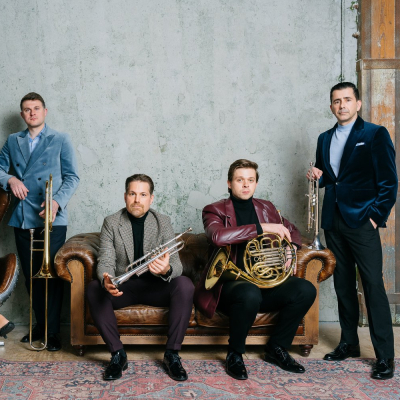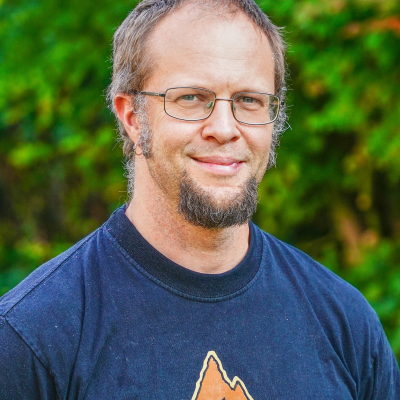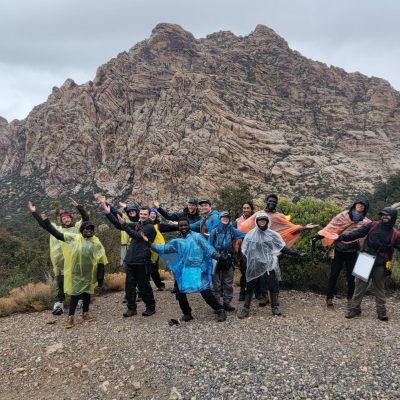News
Stay up-to-date with what's happening in EOAS
The Indigenous Voices Collection Mini-Library at the UBC – Teck Geological Field Station
On May 13, Dr. Laura Lukes (Assistant Professor) and Dr. Silvia Mazabel Ortega (Postdoctoral Fellow) at the Department of Earth, Ocean and Atmospheric Sciences picked up the last of the books from the Nk’Mip Desert Cultural Centre to set up the Indigenous Voices Collection Mini-Library at the UBC-Teck Geological Field Station near Oliver, B.C..
The Indigenous Voices Collection Mini-Library was first unveiled to more than 40 students in the EOSC328 Field Geology course. It is now featuring the local history book One Hundred X One Hundred/ x̌cəcikst X x̌cəcikst co-edited by Jenna Bower, General Manager of the Nk’Mip Desert Cultural Centre.
The Mini-Library emerged from the Earth Science Experiential and Indigenous Learning project (EaSEIL) funded by the UBC Teaching and Learning Enhancement Fund, which aims to reimage, develop, and transform field-based experiential learning opportunities for students. It is a collaboration with the Xwi7xwa Library (Karleen Delaurier-Lyle, Information Services Librarian and Kayla Lar-Son, Indigenous Programs & Services Librarian), EOAS, and EOAS Facilities (Sebastian Medrano, Assistant Director of Facilities and Lindsay Nelson, Earth Science Educational Field and Laboratory Coordinator). Equipment was funded by EOAS Department Funds.
Michael Lipsen recognized with Killam Teaching Award
Congratulations to Michael Lipsen who has been awarded the 2023/24 Killam Teaching Award!
Each year the Killam Teaching Prize is awarded to a faculty member nominated by students, co-faculty and alumni. Lipsen teaches EOSC 315: The Ocean Ecosystem, EOSC 470: Biological Oceanography, and ENVR 200: Introduction to Environmental Science. This year he has been awarded the Killam Teaching Prize and represents teaching excellence within the Dept. of Earth Oceans and Atmospheric Science at the University of British Columbia.
Once again, congratulations on the outstanding achievement.
In memoriam: Charles Krzysik
It is with profound sadness that we announce the passing of our friend and colleague, Charles Krzysik, the Information Technology Manager for the Department of Earth, Ocean and Atmospheric Sciences. Charles joined EOAS in 2013, and became IT manager in 2018. He was known for his kindness, his competence and his selfless commitment to the EOAS community and their computing needs, which was recognized by a Faculty of Science Excellence in Service award in 2019. During his tenure Charles pioneered the use of open-source platforms for data storage, network monitoring and computing, providing critical resources for research and teaching. His energy, technical mastery and positive attitude were always on display, and he would happily do house calls for faculty and staff struggling with home computer issues. Charles was not just a colleague but a dear friend, and he is deeply missed.
What does a green energy transition sound like? Earth Day symphony at the Vogue Theater
Enjoy the symphonies of nature this Earth day at the University of British Columbia Vogue Theater. Indigenous elders, researchers, and musicians have come together to produce the Heavy Metal Suite concert, playing April 22 at 6PM at the Vogue Theater.
The Heavy Metal Suite includes eight new works composed by musicians from around the world. Each composer wrote a piece inspired by an element being harvested from their home country to support green energy transitions. Highlighted elements include lithium from Australia for electric carb batteries, water from Canada for hydroelectric power, and copper from Chile to support growing renewable energy infrastructure.
The concert is produced by the UBC Future Metals Initiative, an interdisciplinary cluster that is connecting leaders across Indigenous communities, Earth Sciences, policy, and engineering to promote equitable development of heavy metal harvesting necessary for emerging green technologies. The group hopes engaging the public through music will spark critical conversations surrounding heavy metals we depend on every day, but often spend little time thinking about. The concert will be released alongside a free ebook, Heavy Metal: Earth’s Minerals and the Future of Sustainable Societies. The ebook, edited by Philippe Tortell, the head of Earth Ocean and Atmospheric Sciences at UBC, is a compilation of essays by experts across disciplines examining different aspects of the mining industry.
Click here to read more about the concert and ebook from co-contributors, Philippe Tortell and Tahltan Nation elder, Allen Edzerza.
Congratulations, Joel Saylor! New Killam Research Fellow
This week UBC has announced the winners of 2023’s Faculty Research Awards, which recognizes research excellence and scholarly achievement of faculty across disciplines. The Department of Earth Oceans and Atmospheric Science is excited to share that Associate Professor Joel Saylor has won the UBC Killam Research Fellowship for established career scientists. Congratulations, Joel Saylor!
Public Debate! How did the Sevier Orogeny define the geology around Las Vegas, Nevada?
This winter graduate and undergraduate students in the Advanced Field Methods course (EOSC 448 and EOSC 546) traveled to Las Vegas, Nevada, to study the outcrops around Frenchman Mountain, Red Rock Canyon, Buffington Pockets, and Valley of Fire State Park.
At Frenchman Mountain the students observed the oldest sedimentary rocks in southern Nevada, which were initially deposited during the Cambrian, around 500 million years ago, following the breakup of the supercontinent of Rodinia. The deposited rocks were primarily limestones and dolomites that form on shallow seabeds due to the sedimentation of calcium carbonate sea shells. During the Mesozoic (~200 million years ago) the region transitioned from a marine to a terrestrial environment, and rock deposition was primarily clastic, i.e. rocks formed from fragments of other rocks.
At Red Rocks Canyon, Buffington Pockets, and Valley of Fire State Park, the students observed the results of the Sevier Orogeny in which the deposited rocks were tectonically squeezed together during this Cretaceous (~100 million years ago) mountain building event. The area was stretched in the Miocene (~17 million years ago) as the plate tectonics of the area changed once again and the San Andreas Fault formed to the west. The result of this complex geological history is dramatic folded and deformed layers as well as deposition of new sedimentary rocks as the mountain building also created new sedimentary basins.
Although the limited desert vegetation of the area means the outcrop and its features are easily visible, there are still unknowns in the story of the Sevier Orogeny. Using their field observations, literature references, and understanding of geological processes gained through EOSC 546, students will debate 1) whether the Sevier Orogeny formed during a distinct event in space and time, or it evolved over time alongside other deformation events, 2) if the geology of the basin surrounding the Sevier Orogeny is typical of a foreland basin. These questions are critical to our understanding of the processes involved in creating these formations and features like them.
The public is welcome at the upcoming debate, taking place March 9 from 9:30 am to noon at Earth Science Building room 5108. There will be a chance for audience members to ask questions after several rounds of rebuttal. The audience will also get to vote for the arguments they find most compelling.
Click here to read more about the EOSC 546 field experience.

